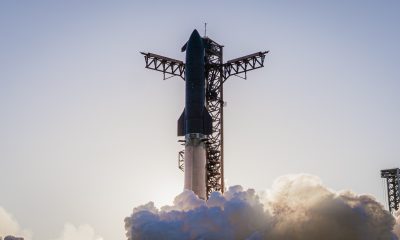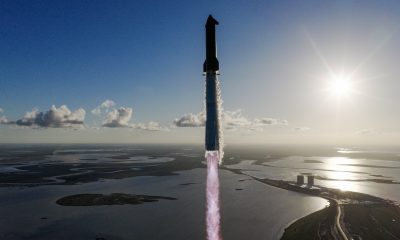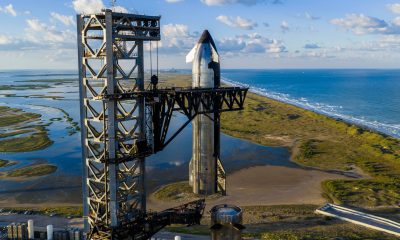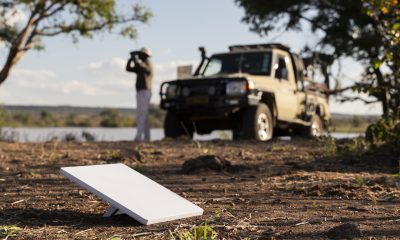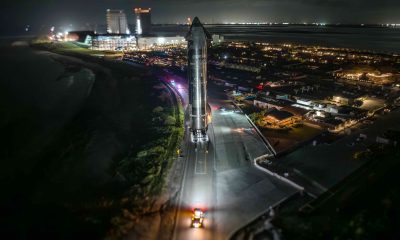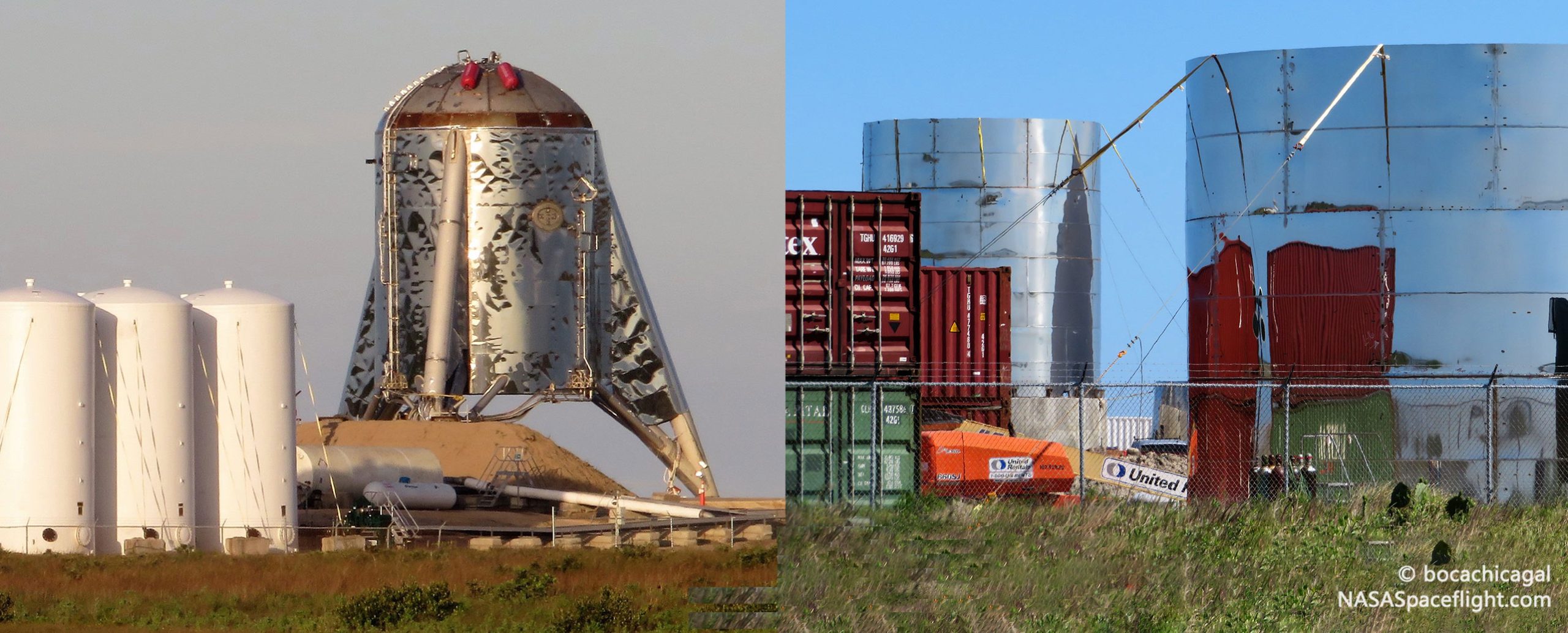
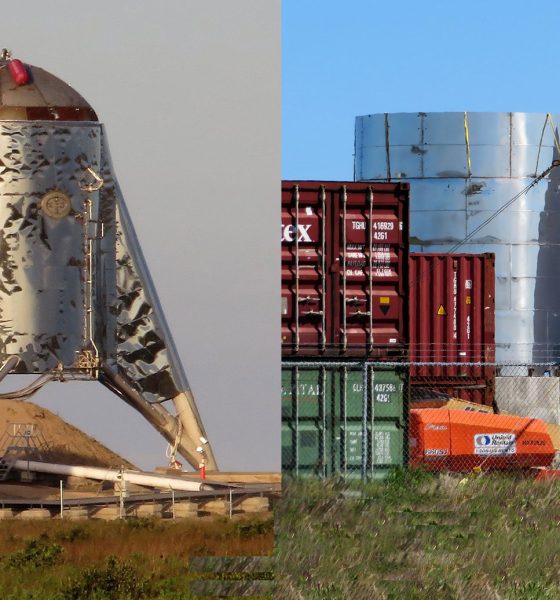
SpaceX
SpaceX builds new orbital Starship sections as Starhopper loses its engine
Amidst the growing buzz centered around the imminent second launch of Falcon Heavy, SpaceX’s South Texas team has continued to work on Starhopper and the first orbital Starship prototype. wrapping up the first major tests of the former and making new progress on the latter’s aeroshell.
For unknown reasons, SpaceX technicians uninstalled Starhopper’s Raptor – the second full-scale engine ever built – shortly after the vehicle’s first true hop test and proceeded to package it up for shipment elsewhere, likely McGregor’s test facilities or the Hawthorne factory. Simultaneously, the third completed Raptor (SN03) was recently installed in McGregor according to photos and observations published by NASASpaceflight.com, preparing to continue to the engineering verification tests that began in February. Once those tests are complete and the engine design is modified to account for the lessons learned with Raptor SN01, SpaceX’s next step will be to begin ramping Raptor production in preparation for multi-engine Starhopper testing and – eventually – the completion of the first orbit-capable Starship prototype.
Needless to say, SpaceX is juggling a lot of interconnected projects in an effort to speed its Starship/Super Heavy (formerly BFR) development program, none of which are being discussed by the company in more than a cursory manner. What follows is thus meant to be an informed but speculative estimate of what is currently going on and what is next for BFR.
Starhopper slips the surly bonds
Over the course of the last two weeks, SpaceX has been almost continuously testing the first integrated Starship prototype, a partial-fidelity vehicle known as Starhopper. The testing primarily involved almost a dozen wet dress rehearsals (WDRs) in which the rocket was filled with some quantity of liquid oxygen and methane propellant and helium for pressurization as engineers and technicians worked through several bugs preventing Raptor from safely operating. According to CEO Elon Musk, some form of ice – potentially methane, oxygen, or even water – was forming in or around parts known as “prevalves”, likely referring to valves involved in the process of supply rocket engines with the right amount of fuel and oxidizer.
Less than 24 hours later, those valve issues were apparently solved as Starhopper’s Raptor ignited for the first time in a spectacular nighttime fireball. 48 hours after that first ignition, SpaceX once again fueled Starhopper and ignited its Raptor engine, lifting a spectacular handful of feet into the air before reaching the end of its very short tethers. According to Musk, the first Raptor ignition was completed with “all systems green”. After the second test, no additional comments were made. Less than three days later, SpaceX technicians uninstalled Starhopper’s Raptor (SN02) and shipped it somewhere offsite, indicating that it may have suffered a fault similar to the one that caused relatively minor damage to Raptor SN01 at the end of its February test campaign. Regardless, it appears that this development will keep Starhopper grounded for the indefinite future barring the imminent shipment of Raptor SN04 or the completion of SN01’s refurbishment.
The Raptor pack grows
Starhopper’s unplanned grounding ties
While the exact strategy behind SpaceX’s Raptor and BFR propulsion development programs
Regardless, the somewhat buggy behavior exhibited by the integrated Raptor and Starhopper indicate the obvious: both are fairly immature hardware still in some form of development, be it the late (Raptor) or the very earliest stages (Starhopper). By performing even more testing and continuing to optimize and gain familiarity with the hardware at hand, the fairly predictable process of development will arrive at more or less finished products.


Starship’s first orbital prototype
Last but not least, work continues on what will hopefully become the first orbit-capable Starship prototype, built in full-scale out of sheets of stainless steel that are far thinner than the metal used to construct Starhopper. This, too, is a normal process of development – as progress is made, prototypes will gradually lose an emergency cushion of performance margins, a bit like a sculptor starting with a solid block of marble and whittling it down to a work of art. Starhopper is that marble block, with inelegant, rough angles and far more material bulk than truly necessary.
As seen above, the orbital prototype – just the second in a presumably unfinished series – is already dramatically more refined. Instead of the first facade-like nose cone built for Starhopper, Starship’s nose section is being built out of smoothly tapered stainless steel panels that appear identical to those used to assemble the rocket’s growing aeroshell and tankage. As of now, there are five publicly visible Starship sections in various forms of fabrication, followed by a half-dozen or so tank dome segments waiting to be welded together as finished bulkheads.
Intriguingly, the only quasi-public official render of SpaceX’s steel Starship features visible sections very similar to those seen on the orbital prototype’s welded hull. They aren’t all visible in the render, but those that are are a distinct match to the aspect ratio of the welded sections visible in South Texas.

Extrapolating from this observation, Starship, as rendered, is comprised of approximately 16 large cylinder sections and 4-8 tapered nose sections. Based on the real orbital prototype, each large section is 9m in diameter and ~2.5m tall. Assuming Starship is 55 meters (180 ft) tall, this would translate into 22 2.5m sections, a nearly perfect fit with what is shown in the official render. Back in South Texas, SpaceX has 6 tapered sections and 7 cylinder sections in work, meaning that they would reach around 32.5m (~105 ft) – about 60% of a Starship hull – if stacked today.
If we assume that SpaceX follows Falcon procedures to build the seven-Raptor thrust structure separately (~2 sections) and excludes most of the cargo bay (~2-3 sections) on the first orbit-capable Starship, those ~13 in-work sections could be just a tapered nose cone away from the prototype’s full aeroshell. Time will tell…
Check out Teslarati’s newsletters for prompt updates, on-the-ground perspectives, and unique glimpses of SpaceX’s rocket launch and recovery processes.
Elon Musk
SpaceX posts Starship booster feat that’s so nutty, it doesn’t even look real
The Super Heavy booster’s feat was so impressive that the whole maneuver almost looked like it was AI-generated.
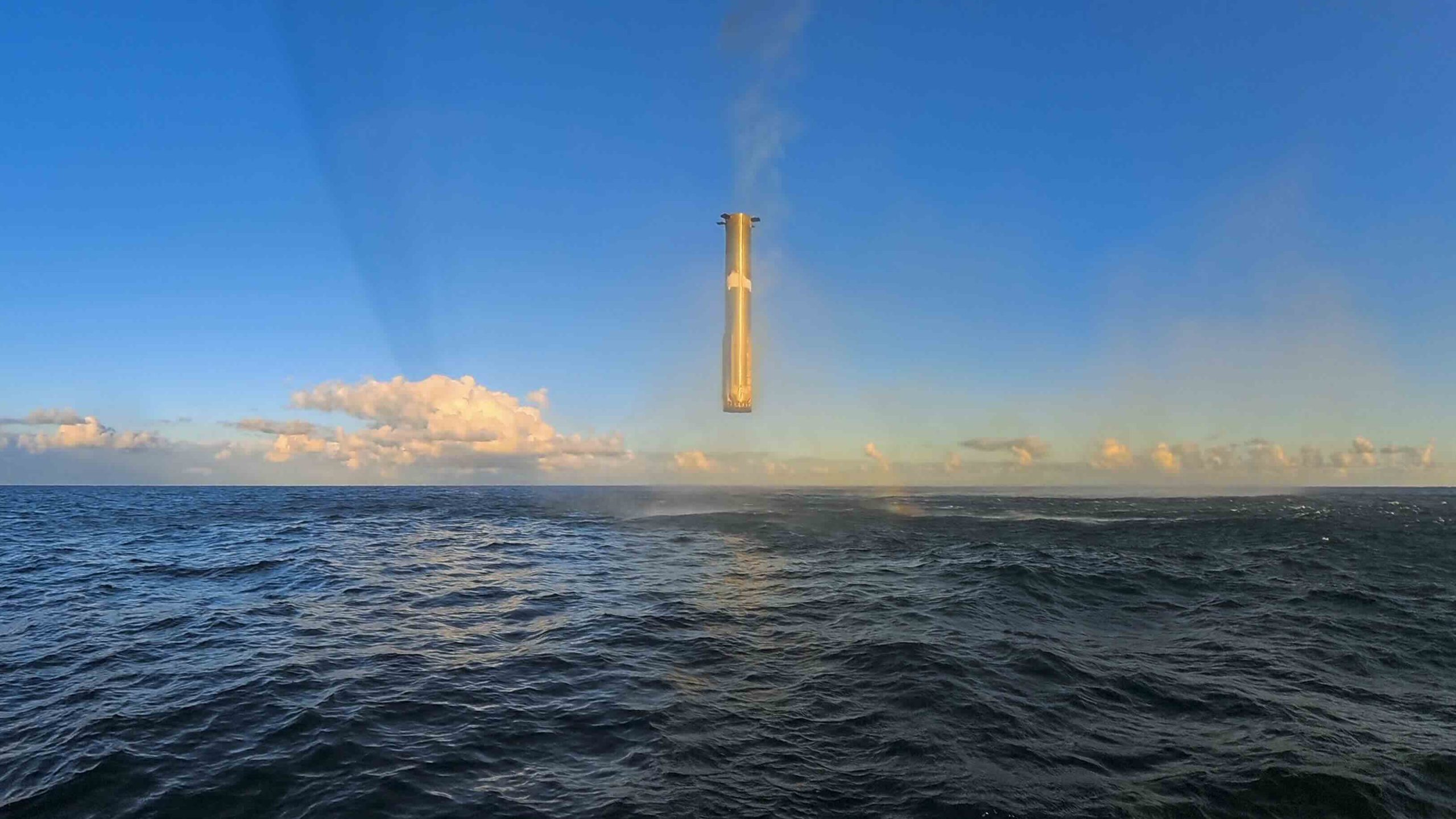
SpaceX has shared a video of a remarkable feat achieved by Starship’s Super Heavy booster during its 11th flight test.
The Super Heavy booster’s feat was so impressive that the whole maneuver, which was captured on video, almost looked like it was AI-generated.
Super Heavy’s picture perfect hover
As could be seen in the video shared by SpaceX, Starship’s Super Heavy booster, which is nearly 400 feet tall, smoothly returned to Earth and hovered above the Gulf of America for a few seconds before it went for its soft water landing. The booster’s picture-perfect maneuver before splashing down all but capped a near-flawless mission for Starship, which is about to enter its V3 era with Flight 12.
The booster’s balance and stability were so perfect that some users on X joked that the whole thing looked AI-generated. Considering the size of Super Heavy, as well as the fact that the booster was returning from space, the hovering display all but showed that SpaceX is dead serious about keeping its dominant lead in the spaceflight sector.
Starship V2’s curtain call
As noted in a Space.com report, Flight Test 11 achieved every major goal SpaceX had set for the mission, including deploying Starlink mass simulators, relighting Raptor engines in space, and executing a stable reentry for both the Starship Upper Stage and the Super Heavy booster. The feat also marked the second time a Super Heavy booster has been reflown, a milestone in SpaceX’s quest to make the entire Starship system fully reusable.
Starship’s V2 vehicle will now give way to the upgraded Starship V3, which is designed for faster turnaround and higher payload capacity. The Starship program is expected to pursue even more aggressive targets in the coming months as well, with Elon Musk stating on social media platform X that SpaceX will attempt a tower catch for Starship Upper Stage as early as spring 2026.
Elon Musk
Starship’s next chapter: SpaceX eyes tower catch after flawless Flight 11
Elon Musk has revealed the tentative timeframe for Starship’s next milestone that would push the spacecraft’s reusability to a whole new level.

Elon Musk has revealed the tentative timeframe for Starship’s next milestone that would push the spacecraft’s reusability to a whole new level.
Following Flight 11’s flawless mission, Musk noted on X that SpaceX will be aiming to catch the Starship Upper Stage with its launch tower as early as spring 2026. This should pave the way for SpaceX to start optimizing Starship for maximum reusability.
Flight 11 closes the Starship V2 chapter on a high note
Starship’s eleventh flight, which launched from Starbase, Texas, achieved every major mission objective. The Super Heavy booster completed a successful ascent, hover, and soft splashdown in the Gulf of America, while the upper stage executed an orbit burn, deployed Starlink simulators, and returned with a controlled reentry over the Indian Ocean.
This mission officially closed the chapter on the second-generation Starship and first-generation Super Heavy booster, and it set the stage for a redesigned vehicle built for orbital payload missions, propellant transfer, and beyond. It should be noted that Elon Musk has mentioned on X that Starship V3, at least if things go well, might be capable of reaching Mars.
Elon Musk confirms tower catch attempt set for spring
After Flight 11’s success, Musk confirmed that SpaceX will attempt to catch the Starship Upper Stage with its launch tower arms, fondly dubbed by the spaceflight community as “chopsticks,” in the coming months. Musk’s announcement came as a response to an X user who asked when the tower could start catching the Starship Upper Stage. In his reply, Musk simply wrote “Springtime.”
Starship’s reusability is a key feature of the spacecraft, with SpaceX aiming to achieve a launch cadence that is almost comparable to conventional aircraft. For such a scenario to be feasible, launch tower catches of both Starship’s Upper Stage and its Super Heavy booster have to be routine.
Elon Musk
SpaceX is preparing to launch Starship V2 one final time
The mission will test reentry dynamics, new landing burn configurations, and heat-shield upgrades.
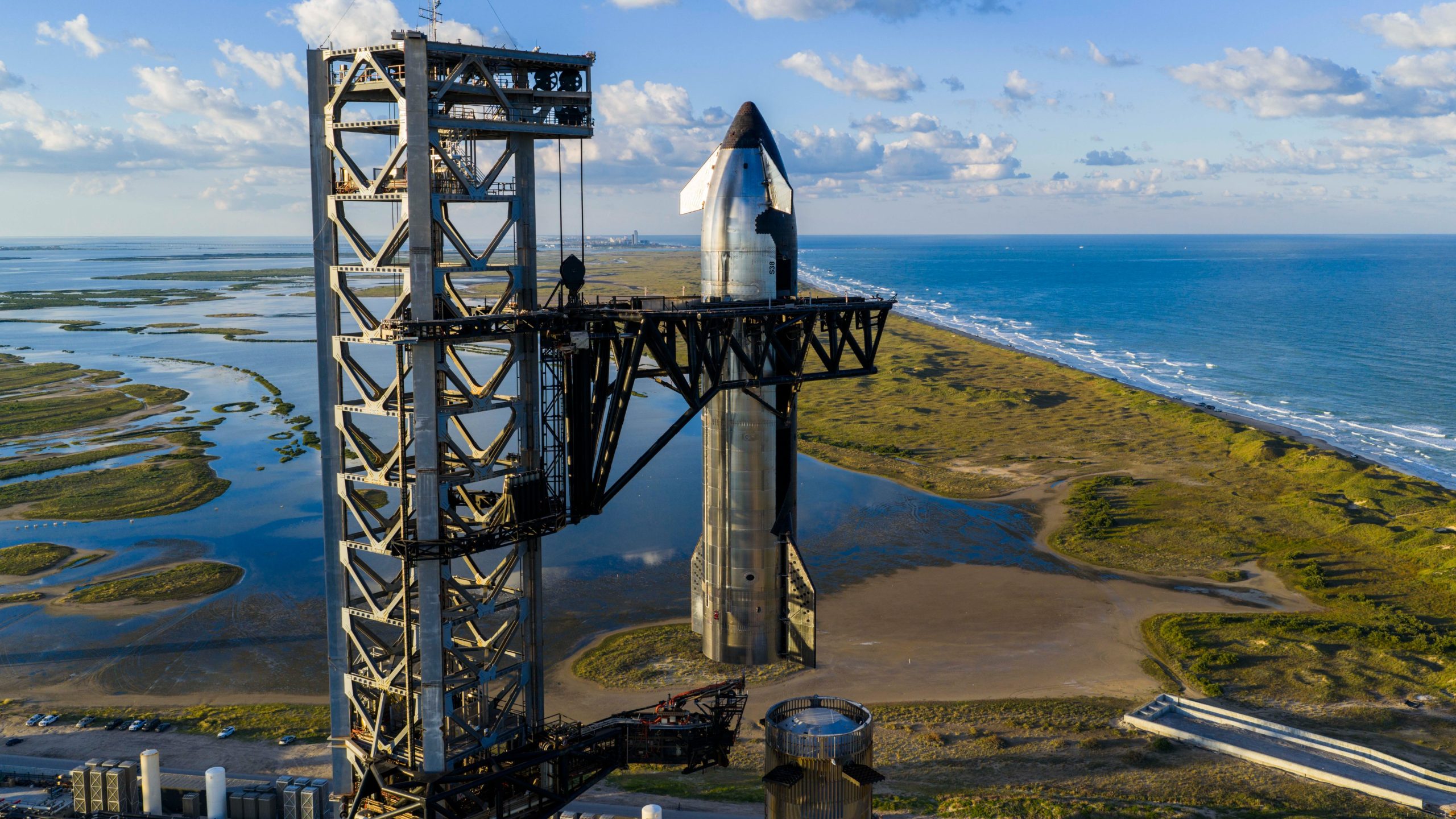
SpaceX is preparing to launch its final Starship V2 rocket on October 13, 2025. The launch closes the curtain on Starship V2 and marks the start of the ambitious spacecraft’s V3 era.
Liftoff for Flight 11 is scheduled for 7:15 p.m. ET from Starbase in South Texas, with a 75-minute launch window. The mission will test reentry dynamics, new landing burn configurations, and heat-shield upgrades ahead of the transition to the next-generation Starship V3.
Starship V3 and beyond
Elon Musk confirmed on X that Starship V3 is already in production and could be “built & tested” and perhaps even flown before the end of 2025. The new version is expected to feature major performance and scale improvements, with Musk stating that Starship V3, provided that things go well, might be capable of reaching Mars, though V4 is more likely to perform a full-scale mission to the red planet.
“Only one more V2 left to launch,” Musk wrote back in August following Starship’s successful Flight 10 mission. In another post, Musk stated that “Starship V3 is a massive upgrade from the current V2 and should be through production and testing by end of year, with heavy flight activity next year.”
Starship V2’s final mission
Flight 11 is designed to push the limits of Starship V2. SpaceX engineers have intentionally removed heat-shield tiles in vulnerable areas to analyze how the vehicle handles atmospheric reentry under stress, as noted in a Space.com report. The test will also refine subsonic guidance algorithms and new landing burn sequences for the Super Heavy booster that would be used for Starship V3.
“Super Heavy will ignite 13 engines at the start of the landing burn and then transition to a new configuration with five engines running for the divert phase. Previously done with three engines, the planned baseline for V3 Super Heavy will use five engines during the section of the burn responsible for fine-tuning the booster’s path, adding additional redundancy for spontaneous engine shutdowns.
“The booster will then transition to its three center engines for the end of the landing burn, entering a full hover while still above the ocean surface, followed by shutdown and dropping into the Gulf of America,” SpaceX wrote in a post on its official website.
-

 Elon Musk1 week ago
Elon Musk1 week agoSpaceX posts Starship booster feat that’s so nutty, it doesn’t even look real
-

 Elon Musk1 week ago
Elon Musk1 week agoTesla Full Self-Driving gets an offer to be insured for ‘almost free’
-

 News1 week ago
News1 week agoElon Musk confirms Tesla FSD V14.2 will see widespread rollout
-

 News1 week ago
News1 week agoTesla is adding an interesting feature to its centerscreen in a coming update
-

 News1 week ago
News1 week agoTesla launches new interior option for Model Y
-

 News1 week ago
News1 week agoTesla widens rollout of new Full Self-Driving suite to more owners
-

 Elon Musk1 week ago
Elon Musk1 week agoTesla CEO Elon Musk’s $1 trillion pay package hits first adversity from proxy firm
-

 News6 days ago
News6 days agoTesla might be doing away with a long-included feature with its vehicles


